GLOBAL WARMING ITS CAUSES AND EFFECT
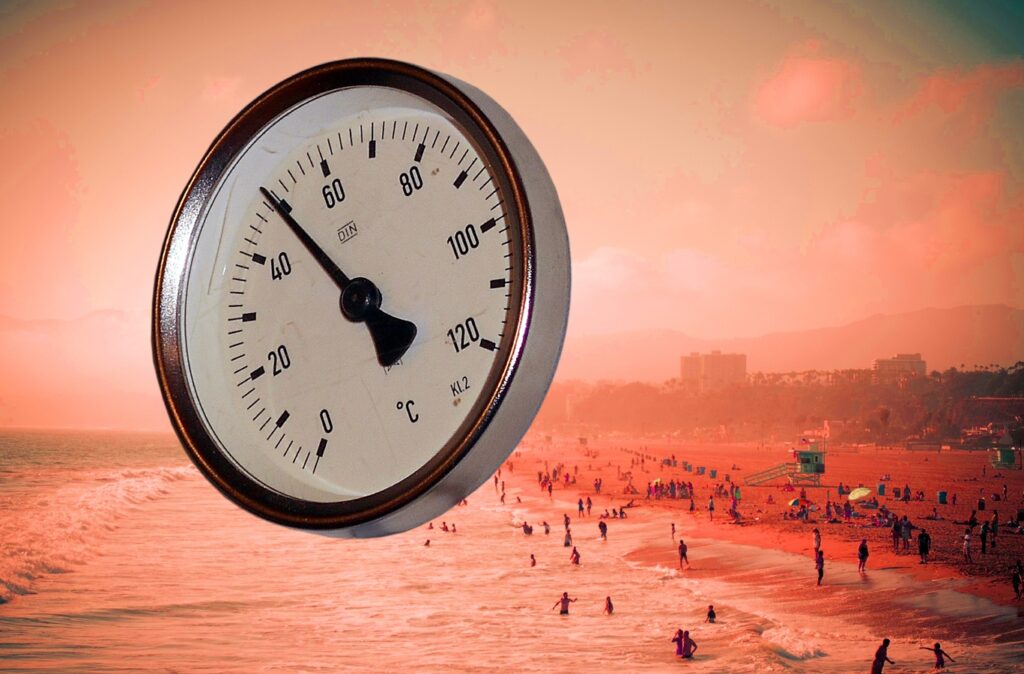
GLOBAL WARMING CAUSES AND EFFECT Mr. Tapan Kumar Das has been associated with MIES Institute for the last 5 years as a Skill Development Officer. He has experience in teaching WBCS, SSC, PSC, RAIL, etc exams. He is very grateful to MIES Management for giving him a chance as a Skill Development Officer at MIES Institute which is one of the best competitive coaching centres in West Bengal. In His opinion, MIES Institute is one of the top competitive exam institutes in West Bengal. This is an awesome write-up from him on GLOBAL WARMING CAUSES AND EFFECT. MIES is a renowned coaching center for Govt. Job exams in West Bengal. Thousands of students appeared in Govt. service exam from MIES every year and got Govt. service maximum of them. MIES is the most popular institute among Govt. Job aspirants because of their specialty in School Service, WBCS, PSC, SSC, BANK, RAIL, etc exams. MIES is a pioneer institute of West Bengal Civil Service coaching in West Bengal. As per the students’ version, MIES is the Best Training Academy for Govt. Job exam in West Bengal. GLOBAL WARMING CAUSES AND EFFECT Introduction : Global warming is mainly a human-caused increase in global surface temperatures due to the rise in this global surface temperature. The earth’s climate also changes. So it is said, from a practical point of view that “Global Warming and climate change are often used interchangeably. Global warming and its effects on climate change include both global warming and climate change as demonstrated by direct temperature measurement and by measurement of various effects of warming. How Global Warming occurs : Global warming occurs when carbon dioxide (CO2) and other air pollutants and greenhouse gases collect in the atmosphere and absorb sunlight and solar radiation that have bounced off the earth’s surface. Normally, this radiation would escape into space – but these pollutants which can last for years to centuries in the atmosphere, trap the heat and cause the planet to get hotter. That is what is known as the greenhouse effect. Lately, the severity of global warming and climate change has been brought to our shocking notice through the hard-hitting bushfires engulfing the country – continent of Australia leaving its ecosystem in peril with over a billion species of animals & birds lost, thousands of human inhabitants displaced and even lost their lives. Effects of it : The effects of global warming include rising sea levels, regional changes in precipitation, more frequent extreme weather events such as heat waves, and the expansion of deserts. Ocean acidification is also caused by greenhouse gas emissions and is commonly grouped with these effects even though it is not driven by temperature. Surface temperature increases are greatest in the Arctic which has contributed to the retreat of glaciers, permanently frozen subsoil, and sea ice. Overall, higher temperatures bring more rain and snowfall, but some regions – increase drought and wildfires. Global warming causing changes in the climate threatens to diminish crop yields, harming food security & rising sea levels may flood coastal infrastructure and force the abandonment of many coastal cities, extinction or relocation of many species from this planet, will global warming cause change in the ecosystem affecting environments of coral reefs, maintains, and the Arctic. How the effects of global warming affecting & destroying the world’s biggest mangrove, the Sunderbans and causing increasingly intense tropical storms including the destruction of nature, houses, and properties & species of this planet : Because of global warming; causing accelerating sea-level rise is likely to submerge the Sunderbans due to the destruction of mangroves. This concerned mangroves of Sunderbans could absorb & resist the high force of wind and wind, lessen the rampage caused by cyclones & other storms. Now scientists predict that under such a continuously increased high emission scenario & sea-level rise may totally inundate most of the Sunderbans by the middle of this century & wipe out totally by the end of the century. It is sure that without the existence of this biggest mangrove, that day is not very far that Kolkata city & its people may go underwater & destroyed due to high wind force and increasingly rising of sea level. The Amazon effects for resistance to global warming interconnected with climatic change : The Amazon in South America is over 2.1 million square miles dense with rain forest which is more than half of the rainforest of the entire planet. Trees use the sun to create glucose from water and carbon dioxide. In the process, they release Oxygen into the air. Hence Amazon’s nickname is “lungs of the world” because it is responsible for so much production of Oxygen. There are concerns that the Amazon could become a net source rather than a sink (storage) of carbon dioxide (CO2), a gas emitted mainly from burning fossil fuels, coal, oil, and natural gas – and the major driver for global climate change. The Amazon due to its massive oxygen release into the atmosphere works in the significant reduction /or resistance to global warming no doubt. This natural massive effect of the Amazon’s vast rainforest causes resistance as well as a reduction in global warming, which today has been destroyed extremely by the multi-nationals as they are invading the Amazon for their business benefit since the high price and demand for Amazonian hardwood all over the world. There are also farmers, Practically cattle ranchers, and soy farmers, who illegally clear areas for their farms. Artificial effects So the bad luck of the planet and its species majorly human beings who are vitally responsible for the deforestation of the Amazon rainforest is progressing rapidly, with close to 20% of the forest gone in the last 40 years. (As per Alejandra Borunda’s Internet published on August 29, 2019) Besides, thousands of fires are burning across a Southern Swath of the Amazon. They belch smoke and root, blanketing those who live downwind with thick, dirty air, hurting wildlife in their path,
Rainfall in India

Rainfall in India by Saugata Singha Mr. Saugata Singha has been associated with MIES Institute for the last 15 years as a guest faculty. He has a lot of experience teaching WBCS, SSC, PSC, RAIL, etc exams. So here is an honest trial from his end to provide this awesome piece of writeup on Rainfall in India. He is very grateful to MIES Management for giving him a chance as a guest faculty to MIES Institute which is one of the best competitive coaching centers in West Bengal. In his opinion, MIES Institute is one of the top competitive exam institutes in West Bengal. MIES is a renowned coaching center for Govt. Job exams in West Bengal. Thousands of students appeared in Govt. service exam from MIES every year and got Govt. service maximum of them. MIES is the most popular institute among Govt. Job aspirants because of their specialty in School Service, WBCS, PSC, SSC, BANK, RAIL, etc exams. MIES is a pioneer institute of West Bengal Civil Service coaching in West Bengal. As per the student’s version, MIES is the Best Training Academy for Govt. Job exam in West Bengal. Rainfall in India India experiences diverse climatic conditions, and its rainfall pattern is influenced by the monsoon winds. The Indian subcontinent primarily witnesses two main types of rainfall: the Southwest Monsoon and the Northeast Monsoon. Southwest Monsoon: Timing: The Southwest Monsoon is the most significant rainfall period for India and typically occurs from June to September. Direction: Moisture-laden winds from the Indian Ocean move towards the Indian subcontinent, bringing heavy rainfall. Regions Affected: The Western Ghats, the Himalayan foothills, and the northeastern states receive substantial rainfall during this monsoon. The Indo-Gangetic plain and the Deccan Plateau also get a significant amount of rain. Northeast Monsoon’s Timing: The Northeast Monsoon occurs from October to December, mainly affecting the southern and southeastern parts of India. Direction: During this period, the winds reverse, and moisture-laden winds move from the Bay of Bengal towards the land. Regions Affected: Mainly in Tamil Nadu (Maximum Rainfall) Andhra Pradesh, Karnataka, and parts of northeastern India receive rainfall during the Northeast Monsoon. Distribution of Rainfall: The amount of rainfall varies across different regions of India. The western coast, especially the Western Ghats, receives heavy rainfall due to orographic features. The eastern coast, particularly during the Northeast Monsoon, also experiences considerable rainfall. The northwestern parts, such as Rajasthan, are arid and receive minimal rainfall. Monsoon Variability: Monsoon rains are crucial for agriculture in India, as a significant portion of the country relies on rainfed agriculture. Variability in monsoon patterns can impact agricultural output and the overall economy. Monsoon Forecasting: The India Meteorological Department (IMD) plays a crucial role in forecasting and monitoring the monsoon. They release seasonal forecasts that are vital for agricultural planning and water resource management. Monsoon Challenges: In some years, there may be instances of excess or deficient rainfall, leading to floods or droughts, respectively. Climate change is also influencing monsoon patterns, contributing to increased variability and uncertainties. Understanding the rainfall patterns is essential for various sectors in India, including agriculture, water resource management, and disaster preparedness. The timely and adequate distribution of rainfall is critical for sustaining the country’s diverse ecosystems and supporting its agricultural practices. The Southwest Monsoon is a crucial weather phenomenon for India, bringing the majority of the country’s annual rainfall. It is a seasonal wind pattern characterized by the reversal of wind direction, bringing moisture-laden air from the Indian Ocean to the Indian subcontinent. Here are key aspects of the Southwest Monsoon in India: Wind Reversal: During the Southwest Monsoon, the prevailing wind direction over the Indian subcontinent reverses. The normal wind direction is from land to sea, but during the monsoon, moist air from the southwest (Indian Ocean) replaces the dry air over the Indian subcontinent. Rainfall Distribution: The Western Ghats, the Himalayan foothills, and northeastern India receive the heaviest rainfall during the Southwest Monsoon. The monsoon winds hit the Western Ghats first, leading to orographic rainfall on the windward side (west), creating lush landscapes and supporting biodiversity. The rain shadow effect occurs on the leeward side (east) of the Western Ghats, resulting in drier conditions in certain regions. Agricultural Importance: The Southwest Monsoon is crucial for Indian agriculture, as a significant portion of the country’s farmland relies on rainfed cultivation. Timely and adequate monsoon rainfall is essential for a successful sowing and cropping season. Monsoon Variability: Monsoon rainfall can vary from year to year, impacting agricultural productivity. Years with deficient rainfall may lead to drought conditions, affecting crops and water resources. Economic Impact: The Southwest Monsoon has a significant impact on the Indian economy, influencing agricultural output, food production, and overall economic well-being. Monsoon Retreat: The withdrawal of the Southwest Monsoon begins around September, starting from the northwestern parts of India and gradually moving towards the southeast. Understanding the Southwest Monsoon is essential for farmers, policymakers, and various sectors in India. The monsoon’s dynamics significantly influence water availability, agricultural practices, and the overall socioeconomic conditions of the country. The Northeast Monsoon, also known as the winter monsoon or the post-monsoon season, is a seasonal wind pattern that brings rainfall to parts of India during the winter months. It is a regional reversal of wind direction, and it mainly affects the southern and southeastern regions(Tamil Nadu) of India. Here are some key points about the Northeast Monsoon in India: Direction of Winds: During the Northeast Monsoon, the winds reverse their direction, moving from land to sea. Moisture-laden winds from the Bay of Bengal and the northeastern part of the Indian Ocean move towards the eastern coast of India. Regions Affected due to Rainfall in India: The primary areas affected by the Northeast Monsoon in India include the southeastern coast, parts of the eastern coast, and some inland areas. States such as Tamil Nadu, Andhra Pradesh, Karnataka, and parts of Telangana receive a significant amount of rainfall during this monsoon. Rainfall Pattern: The rainfall during the Northeast Monsoon
COMBINED HIGHER SECONDARY LEVEL EXAMINATION 2024
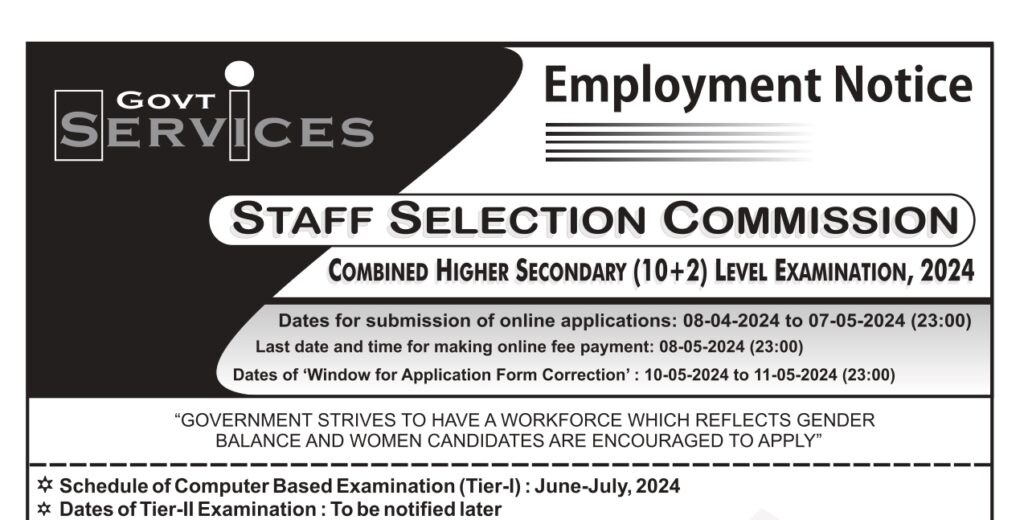
COMBINED HIGHER SECONDARY LEVEL EXAMINATION 2024 by Staff Selection Commission COMBINED HIGHER SECONDARY LEVEL EXAMINATION 2024 (10+2) by Staff Selection Commission. The Staff Selection Commission will hold a competitive examination for recruitment to the Group C posts viz. Lower Divisional Clerk/ Junior Secretariat Assistant and Data Entry Operators for various Ministries/Departments/ Offices of the Government of India and various Constitutional Bodies/Statutory Bodies/Tribunals, etc.. GOVERNMENT STRIVES TO HAVE A WORKFORCE WHICH REFLECTS GENDER BALANCE AND WOMEN CANDIDATES ARE ENCOURAGED TO APPLY” *Schedule of Computer Based Examination (Tier-I) :June-July, 2024Dates of Tier-II Examination :To be notified later AGE LIMIT (As on 01-08-2024): The Age limit for the posts is 18-27 years i.e. Candidates born not before 02-08-1997 and not later than 01-08-2006 are eligible to apply. ESSENTIAL EDUCATIONAL QUALIFICATIONS (As of 01-08-2024): APPLICATION FEE: IMPORTANT INSTRUCTIONS TO CANDIDATES BEFORE APPLYING, CANDIDATES MUST GO THROUGH THE INSTRUCTIONS GIVEN IN THE NOTICE OF EXAMINATION VERY CAREFULLY. THE NOTICE OF EXAMINATION IS PRINTED BOTH IN ENGLISH AND HINDI. IN CASE OF ANY DISPUTE, THE ENGLISH VERSION WILL PREVAIL. ***For any details please go through the original notification.**** Application link: https://ssc.go.in
LAND REFORMS AND LAND OWNERSHIP
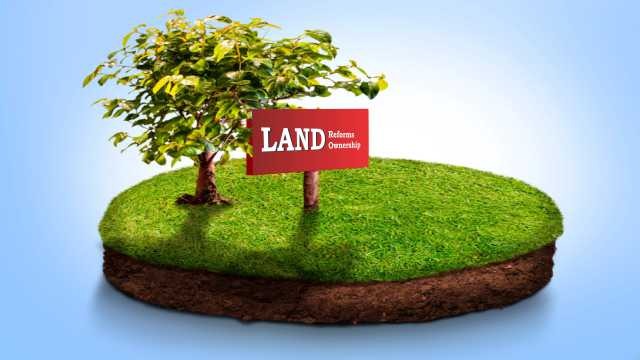
LAND REFORMS AND LAND OWNERSHIP One of the Top Competitive institutes in West Bengal, MIES Institute, puts an informative article on “ Land Reforms and Land Ownership”. Written by the top faculty Mr. Samrat Bhattacharyya of MIES R. M. Law College under MIES Institute. This is the top Coaching Centre for different government job exam preparation, which will enhance and aware more to peoples. Moreover, the MIES Institute is one of the Best institutes for School Service, WBCS, SSC, PSC, Bank, Rail, etc exams in West Bengal. The Head Office is at Sonarpur, Main City Centre – Sealdah. Branches – Barasat, Behala Chowrasta. This article is most effective for the West Bengal Civil Service Exam and other Govt. Service Examinations. Land reforms and land ownership is a very vital matters all over the world “The life of the law has not been logic, It has been experienced”[1]. Is nowhere more clearly illustrated than in the history of the constitutional provisions relating to land reforms in India. There is a wide range of social, political, and economic implications of land reforms in India. Land reforms and land ownership is a very vital matters all over the world. Different political systems prescribed different methods for land ownership and utilization. Land reforms refer to reforming the ownership and regulation of land or redistribution of land from the erstwhile feudal owners or zamindars to the landless people who are suppressed and exploited for a long time for some special purposes like agriculture or economic development of the state. Moreover, Land was concentrated in the hands of a few and there was a proliferation of intermediaries who had no vested interest in self-cultivation. Therefore, Land records were in extremely bad shape and one problem of agriculture was that the land was fragmented into very small parts. Different categories of reform There are different categories of reform abolition of intermediaries, like rent collectors, regulation of tenancy by regulating rent and providing security of tenure, ceiling on land holdings by redistribution of surplus land, consolidation of land, encouraging peasants to form co-operative farming societies so that organized farming can enhance the productivity of the land which can ultimately boost the economy. The consolidation of land started with the Zamindari Abolition Act and Estate Acquisition Act and in West Bengal, the process of land reforms started with Operation Barga which asked for equal distribution of land among the landless farmers. The aim is to equitable redistribution of land to increase productivity and decrease poverty and this can also help to stop intra-country migration of those people who migrate to other states in search of work. Transfer of Property Act As per the Transfer of Property Act, a person cannot transfer a property if he doesn’t have a good title over it. As no one can transfer a better title than he possesses. Earlier ostensible owner of an immovable property who is not the actual owner of that property but rather holds the property in the absence of the real owner with implied or express consent of the actual owner. However after the enactment of Benami Transactions (Prohibition Act) 1988, a transfer by an ostensible owner becomes illegal. Transfer of land or other immovable property can be effected only by a deed of conveyance which has to be duly stamped and registered as required by law. It has become a practice to effect the transfer of immovable property either through a general power of Attorney sales or sale agreement, this sale generally evades payment of duty, taxes, and other fees payable on transfer and registration, so it is an illegal practice and cannot be recognized as valid under law. The persons who resort to such practices include vendors with imperfect titles purchasers who purposefully do not wish to disclose such transfers in the public domain, purchasers who avoid the payment of stamp duty that results eventually in loss of revenue to the government and the circulation of the black money in the market. Sale deed for LAND REFORMS AND LAND OWNERSHIP Buyer must always ensure that the title of the seller is clear before the execution of the sale deed. A Good Title consists of the right of possession and property. Moreover, the transferee of land must ensure that there is no charge encumbrance or any other legal hindrance on the property. The purchasers must verify the encumbrance status from the register’s office. The owner of the land must have an absolute interest in the plot of land as against the lessee, mortgagee, baradari, and patta holder who have a limited interest in the plot of land. The record of rights must contain all aspects of good title, the total area of the plot of land, khatiyan number which is the registration information of the complete records of the land or property. The certified copies of all entered documents in the official domain are issued by the revenue department of the state government. Moreover, these copies are proof of ownership, location, usage, and other information about the land property, and share of raiyat in the plot. Nevertheless, accounts of existing encumbrances like mortgage, adverse possession, or bargain the plot. Without a good title, the transfer is not possible The transferor who wishes to transfer the plot of land must clear the revenue payable to the state government. And any existing encumbrance like mortgaging the land to any land mortgage bank or any other financial institution or any co-operative society must be timely intimated to the revenue officer having jurisdiction so that the encumbrance can reflect in the record of rights. No transferor can legally transfer his land without having a good title. The buyer or transferee has to make himself satisfied that the seller has a good title over such immovable property given in the transfer if he does not want to face any legal consequence of purchasing such disputed property. MIES is a renowned coaching center for Govt. Job exams MIES is a renowned coaching center for
Indian National Movement
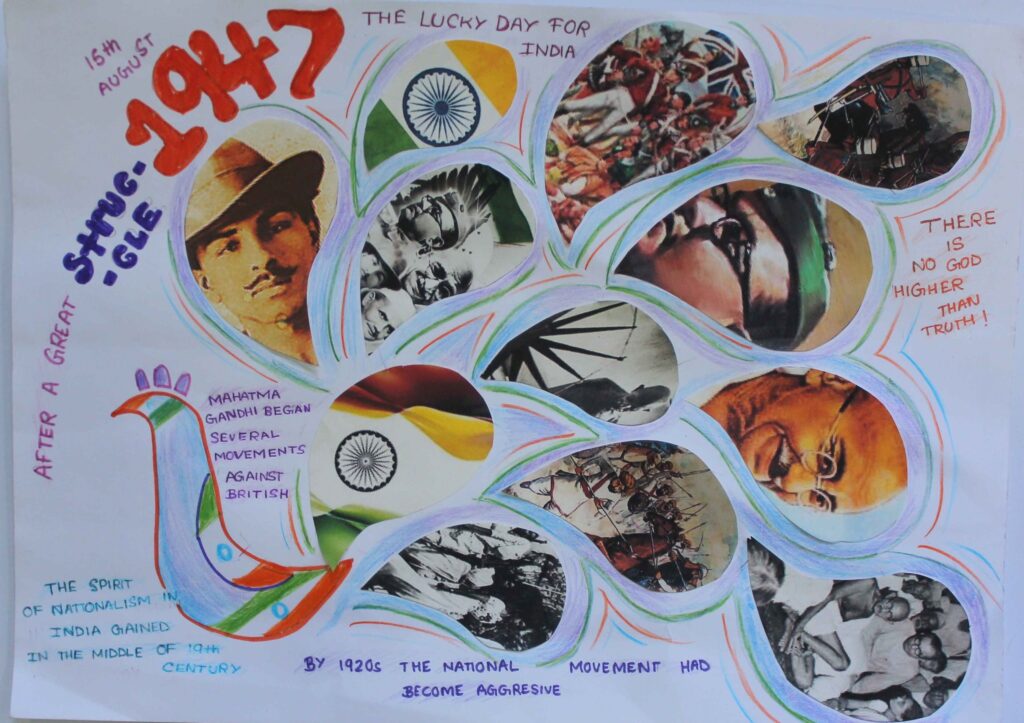
Indian National Movement Mr. Prodipta Chatterjee wrote this article in the Indian National Movement. He has been associated with MIES Institute for the last 15 years as a guest faculty. Has experience teaching WBCS, SSC, PSC, RAIL, etc exams. Moreover, he is very grateful to MIES Management for giving him a chance as a guest faculty to MIES Institute which is one of the best competitive coaching centres in West Bengal. In His opinion, MIES Institute is one of the top competitive exam institutes in West Bengal. Candidates preparing for the WBCS exam should focus on these key aspects. Concerning the Indian National Movement within the context of the history syllabus. The First War of Independence in India Often referred to as the Sepoy Mutiny or the Indian Rebellion of 1857, was a significant uprising against British rule. The rebellion took place between 1857 and 1858 and had widespread repercussions on the course of Indian history. Here are key aspects of the First War of Independence: Causes of Indian National Movement: 1. Military Grievances: The immediate cause was the introduction of the new Enfield rifle, whose cartridges were rumored to be greased with animal fat (cow and pig fat). This offended both Hindu and Muslim sepoys (Indian soldiers), as using such cartridges violated their religious beliefs. 2. Economic Exploitation: The economic policies of the British East India Company, which led to land revenue policies and the imposition of heavy taxes, created widespread agrarian discontent. 3. Social and Cultural Factors: There was a growing sense of resentment among the Indian soldiers and the civilian population due to perceived cultural and religious insensitivity by the British. 4. Annexation of Kingdoms: The annexation of various Indian states and the policy of annexation led to the displacement of many rulers and contributed to the discontent. 5. Sepoy Influence: The sepoys, who were an integral part of the British Indian Army, played a crucial role in the rebellion. Their discontent spread quickly, leading to a widespread uprising. Barrackpore Mutiny (1857): The rebellion began in Barrackpore when sepoys refused to use the controversial cartridges. Leading to a series of events that culminated in the outbreak of the larger rebellion. Siege of Delhi: Rebels captured Delhi in May 1857, and the last Mughal emperor, Bahadur Shah II, was proclaimed the leader of the rebellion. Repression: The British responded with a ruthless crackdown, leading to widespread arrests, executions, and reprisals against the rebels. End of the East India Company The British Crown took control of India from the East India Company in 1858, and the British government pursued a more direct and assertive rule. The First War of Independence marked a turning point in India’s history, leading to the end of the East India Company’s rule and the beginning of direct British governance in India. It also had a lasting impact on the Indian psyche and contributed to the subsequent nationalist movements against British colonial rule. The Moderate Phase of the Indian National Movement spanning roughly from 1885 to 1905 refers to the initial years of the Indian National Congress (INC) and the political approach adopted by its early leaders. The leaders during this phase were often labeled as “Moderates” due to their relatively moderate and constitutional methods of seeking political reforms within the framework of the British colonial administration. Early Leaders (Moderates): The early leaders of the INC during this phase were often referred to as Moderates. Some prominent leaders include DadabhaiNaoroji, WomeshChunderBonnerjee, DinshawWacha, DadabhaiNaoroji, and Gopal Krishna Gokhale. Aims and Objectives: The Moderates focused on constitutional methods, petitions, and resolutions to convey Indian grievances to the British authorities. They sought to create a platform for dialogue and cooperation between the British and Indians. Leaders like DadabhaiNaoroji presented economic critiques of British policies, emphasizing the economic drain from India to Britain and the need for economic self-sufficiency. Educational and Social Reforms: The Moderates also focused on educational and social reforms, aiming to promote modern education and social progress among Indians. Despite their efforts, the Moderates faced challenges, as the British government was often unwilling to grant significant concessions. The lack of mass support and the limited impact of their methods became apparent. The Indian National Congress (INC) Was founded in 1885 and played a crucial role in the Indian independence movement. The formation of the INC marked a significant development in the political landscape of British India The first session of the Indian National Congress was held from December 28 to December 31, 1885, at GokuldasTejpal Sanskrit College in Bombay (now Mumbai). The session was attended by 72 delegates from different parts of the country, representing different communities and interests. The INC aimed to obtain a greater share in government for educated Indians. The early demands were focused on constitutional reforms, representation, and civil rights for Indians within the British colonial framework. The INC gradually transformed into a symbol of the Indian nationalist movement. As the struggle for independence intensified, the INC became the principal political party representing the aspirations of a united India. The foundation of the Indian National Congress marked the beginning of organized political activity in India against British rule. Over the years, the INC played a central role in shaping India’s destiny, eventually leading the country to independence in 1947. The Partition of Bengal 1905 was a controversial administrative reorganization carried out by the British colonial authorities in India. The decision sparked widespread protests and had significant political and social implications. Here are the key details surrounding the Partition of Bengal. Administrative Reasons: The British claimed that the partition was driven by administrative efficiency. Bengal, at the time, was one of the largest provinces in British India, and the authorities argued that dividing it would make administration more manageable. Date: The formal announcement of the partition was made on July 19, 1905, and it took effect on October 16, 1905. Territorial Changes: Bengal was divided into two separate entities – East Bengal and Assam, with a majority Muslim population, and the rest
MISCELLANEOUS SERVICES RECRUITMENT EXAMINATION 2023
MISCELLANEOUS SERVICES RECRUITMENT EXAMINATION 2023 by Public Service Commission, West Bengal. MODE OF APPLICATION: Applications can be submitted online only. SUBMISSION OF MORE THAN ONE APPLICATION BY THE SAME CANDIDATE IS STRICTLY FORBIDDEN AND SUCH APPLICATIONS ARE LIABLE TO CANCELLATION. QUALIFICATION: N.B: The candidates must fulfill the requisite qualifications by the closing date of submission of application. AGE (As on 01.01.2023): Not below 20 years but not more than 39 years as on 01.01.2023 (i.e. born not earlier than 2nd January, 1984and not later than 1st January, 2003). N.B.: Age as recorded only in the Madhyamik or equivalent certificate will be accepted. The age limits apply to all the candidates whether in Govt. service or not. RELAXATION IN AGE LIMIT: The upper age limit is relaxable by 5 years for S.C. & S.T.Candidates of West Bengal and by 3 years for OBC (Non-Creamy Layer) candidates of W.B. In the case of Persons with Benchmark Disabilities (PwBD) the upper age is relaxable upto 45 years. No relaxation is applicable to SC/ST/OBC candidates of other States as they shall be treated as General Candidates. For Offline Payment through any Bank Counter: Service Charge of Rs. 17/-(Rupees Seventeen only). For further details and assistance the candidates may contact the following numbers on any working day from 11-00 a.m. to 4-00 p.m.: For Technical Support : Help Desk :(033) 4058-5640 Email id: pscwbit01@gmail.com
Recruitment of PROBATIONARY OFFICERS (P.O.) / MANAGEMENT TRAINEES
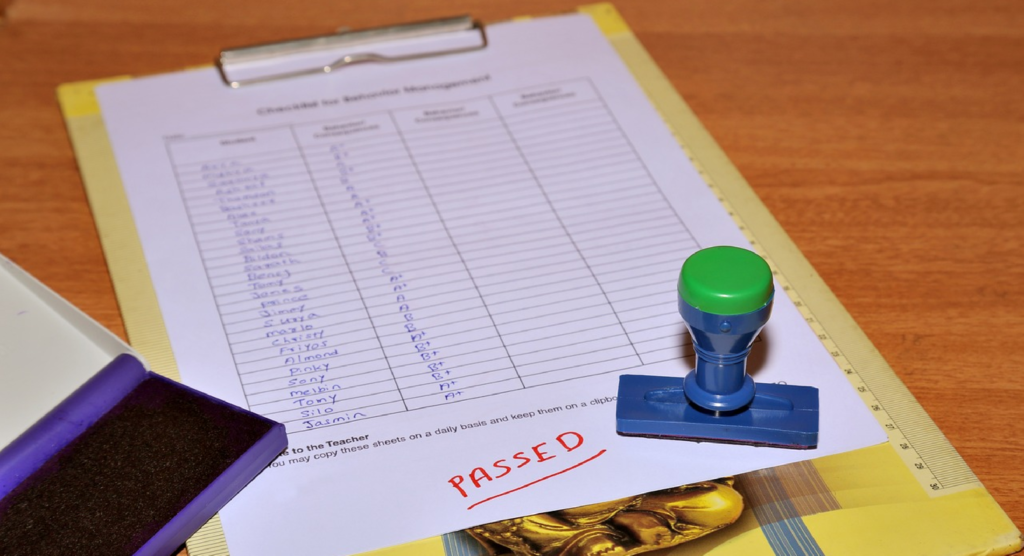
Recruitment of PROBATIONARY OFFICERS (P.O.) / MANAGEMENT TRAINEES In Participating Banks (CRP PO/MT-XIII for Vacancies of 2024-25) conducted by the Institute of Banking Personnel Selection (IBPS) On-line registration including Edit/Modification of Application by candidates and Payment of Application Fees (only Online): 01.08.2023 to 21.08.2023 Date of Online Preliminary Exam.: Preliminary Exam is tentatively scheduled for September/ October 2023. Date of Online Main Exam. : Main Exam is tentatively scheduled for November 2023 PARTICIPATING BANKS : Bank of Baroda Punjab National Bank Bank of Maharashtra Canara Bank Central Bank of India Indian Bank Indian Overseas Bank Punjab National Bank Puniab & Sind Bank UCO Bank Union Bank of India Age for Recruitment of PROBATIONARY OFFICERS (P.O.) / MANAGEMENT TRAINEES •Relaxation of Upper age limit: SC/ ST – 5 years, OBC – 3 years.Persons With Disabilities – 10 years, Others as per rules. Educational Qualifications – (As of 21-07-2023) A Degree (Graduation) in any Discipline (As of 21.08.2023): A Degree (Graduation) in any discipline from a University recognized by the Govt. Of India or any equivalent qualification recognized as such by the Central Government. The fraction of the percentage so arrived will be ignored i. e. 59.99% will be treated as less than 60% and 54.99% will be treated as less than 55%. HOW TO APPLY for Recruitment of PROBATIONARY OFFICERS (P.O.) / MANAGEMENT TRAINEES : Candidates can apply online only from 01.08.2023 to 21.08.2023 and no other mode of application will be accepted• .- Pre-Requisites for Applying Online Before applying online, candidates should scan their : -left thumb impression (If a candidate does not have a left thumb, he/she may use his/ her right thumb. If both thumbs are missing, the impression of one of the fingers of the left hand starting from the forefinger should be taken. If there are no fingers on the left hand, the impression of one of the fingers of the right hand starting from the forefinger should be taken. Ifnofingers are available, the impression of the left toe may be taken. In all such cases where the left thumb impression is not uploaded, the candidate should specify in the uploaded document the name of the finger and the specification of the left/right hand or toe). – a handwritten declaration (text given below). The handwritten declaration has to be in the candidate’s handwriting and in English only. If it is written by anybody else and uploaded in any other language, the application will be considered as invalid. (In the case of candidates who cannot write, may get the text of the declaration typed and put their left-hand thumb impression (if not able to sign also) below the typed declaration and upload the document as per specifications.) (Name of the candidate), hereby declare that all the information submitted by me in the application form is correct, true, and valid. I will present the supporting documents as and when required. “
Recruitment of CLERKS in participating Banks

Recruitment of CLERKS in participating Banks (CRP CLERKS-XIII for Vacancies of 2024-25) by Institute of Banking Personnel Selection (IBPS) On-line registration including Edit/Modification of Application by candidates and Payment of Application Fees (only Online): 01.07.2023 to 21.07.2023 Date of Online Preliminary Exam. : Preliminary Exam is tentatively scheduled in August/ September 2023. Date of Online Main Exam.: The main exam is tentatively scheduled for October 2023. PARTICIPATING BANKS : Bank of Baroda Canara Bank Indian Overseas Bank UCO Bank Bank of India Union Bank of India Punjab National Bank Union Bank oflndia Bank of Maharashtra Indian Bank Punjab & Sind Bank Age for Recruitment of CLERKS in participating Banks (As on As of 01.07.2023): Minimum: 20 years Maximum: 28 years i.e.A candidate must have been born not earlier than 02.07.1995 and not later than 01.07.2003 (both dates inclusive) • Relaxation of Upper age limit: SC/ ST – 5 years, OBC – 3 years.Persons With Disabilities – 10 years, Others as per rules. Educational Qualifications – (As of 21-07-2023) A Degree (Graduation) in any Discipline From a University recognized by the Govt. Of India or any equivalent qualification recognized as such by the Central Government. The fraction of the percentage so arrived will be ignored. i.e. 59. 99% will be treated as less than 60% and 54. 99% will be treated as less than 55%. Application Fees/ Intimation Charges: [Payable from 01.07.2023 to 21.07.2023 (Online payment), both da es inclusive) 175/- (inclusive of GST) for SC/ST/PWBD candidates. 850 /- (inclusive of GST) for all others. Bank Transaction charges for Online Payment of application fees/ intimation charges will have to be borne by the candidate HOW TO APPLY: Candidates can apply online only from 01.07.2023 to 21.07.2023 and no other mode of application will be accepted. Pre-Requisites for ApplyingOnline Before applying online, candidates should (i) scan their : Clause J (viii) [*Original Notification](if applicable) should be properly scanned andshould not besmudged/ blurred. (Name of the candidate), hereby declare that all the information submitted by me in the application form is correct, true and, valid. I will present the supporting documents as and when required.”
West Bengal Madrasah Service Commission
The West Bengal Madrasah Service Commission will conduct the 7th State Level Selection Test (Assistant Teacher),2023 The West Bengal Madrasah Service Commission will conduct the 7th State Level Selection Test (Assistant Teacher),2023 [7th SLST(AT),2023] for recruitment in tentative vacancies for the posts of Assistant Teachers for classes IX-X & classes XI-XII in non-Government, Aided Madrasahs of West Bengal as per West Bengal Madrasah Service Commission Recruitment (Selection and Recommendation of persons for Appointment and Transfer to the Posts ofTeacher and Non-Teaching Staff) Rules,2023 and as per NCTE guidelines. The online portal for submission of applications will be opened from: 12.05.2023 (4 p.m. onwards) to 12.06.2023. (12 p.m. midnight) AGE LIMIT (As of 01-01-2022): General Category: Minimum: 21 years as of 01.01.2023 (i.e., not born after 01.01.2002). Maximum: 40 years as of 01.01.2023 (i.e., not born before 01.01.1983) SC/ST Category: Relaxation of Maximum age for SC/ST/PH (Disability 40% and above) Candidates: Maximum: 45 years as of 01.01.2023 (i.e., not born before 01.01.1978) OBC Category: Relaxation of Maximum age for OBC Candidates: Maximum: 43 years as of 01.01.2023 (i.e., not born before 01.01.1980). …………………………………………………………………………………………………………………………… ………………….. …………………………………. …………………………….. ESSENTIAL EDUCATIONAL QUALIFICATIONS (Selection of Graduate Teachers for ClassesIX-X): i) Graduate or Post Graduate with 50% marks with B.Ed. or Graduate or Post Graduate with 45% marks with B.Ed.before 29.07.2011. ii) Studied 300 marks in the concerned subject. ESSENTIAL EDUCATIONAL QUALIFICATIONS (Selection of Graduate Teachers for Classes XI-XII): Post Graduate in the concerned subject with 50% marks with B.Ed., or, Post Graduate in concerned MODE OF SELECTION: SELECTION OF GRADUATE TEACHERS FOR CLASSESIX-X: Main Examination (OMR -MCQ): 90 marks SELECTION OF POSTGRADUATE TEACHERS FOR CLASSES XI-XII: Main Examination (OMR -MCQ): 90 marks HOW TO APPLY: Applications must be submitted in only online mode at the website of WBMSC http://www.wbmsc.com Moreover, Candidates are advised in their own interest to submit online applications much before the closing date. And not to wait till the last date to avoid the possibility of disconnection/ inability or failure to login to the website on account of heavy load on the website during the closing days. PROCESS OF FILLING UP THE ONLINE APPLICATION FORM : There are four steps in this process (1. Register,2.Academics,3. Self Declaration,4.Payment) I: Applicant has to register himself/herself first. II: In this step, applicants have to fill out their academics. Ill: Self Declaration needs to be given by the applicant in this step. Step IV: Applicants make his/her payment of Rupees.500/-or 250/-through online payment gateway to complete the application process. The cost of the application is non-refundable. Document required at the time of application: Scan copy of applicant’s photo and signature, size- maximum 100 KB each, format JPEG/JPG or PNG.
Indian Air force Career Opportunities
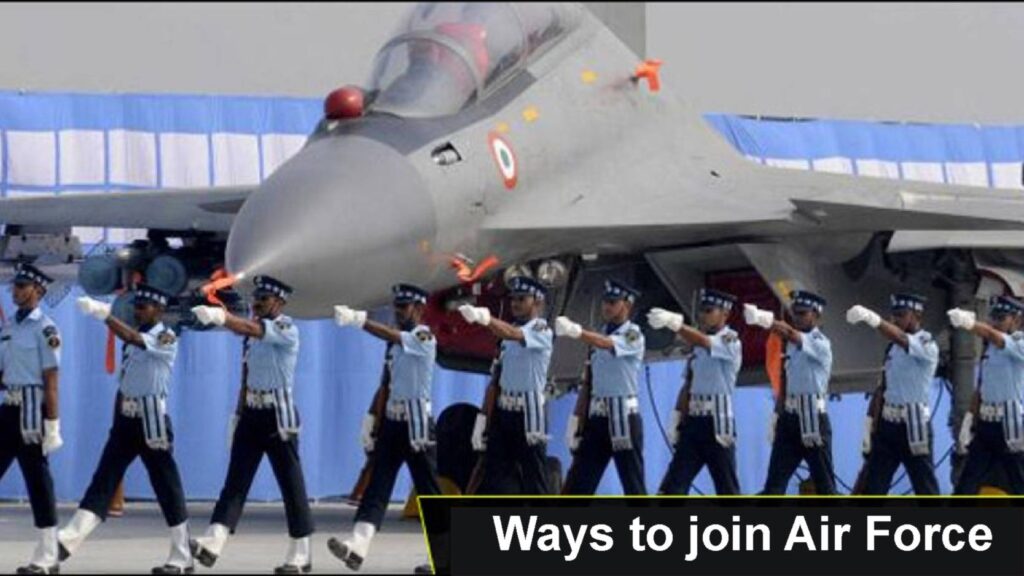
Indian Air force Career Opportunities One of the Top Competitive Institute in West Bengal, MIES Institute, puts an informative article An article on “Indian Air force Career Opportunities” has been written by Mr. Sanjay Nath, Executive officer (Admin) of MIES R M Law College, an excellent law college in Bengal. under MIES Institute, Top most Coaching Centre for different Govt. Job exam preparation will enhance and aware more to mankind. MIES Institute is one of the Best Institute for WBCS and Banking service exam in West Bengal, and also the Institute in School Service exam, Head Office at Sonarpur, Main City Centre – Sealdah. Branches – Barasat, Behala Chowrasta, Howrah Maidan, Konnagar, Chinsurah, and Buniadpur. The Indian Air Force ( IAF) is a branch or part of the Indian Defence Force & its prime responsibility is for aerial warfare and surveillance. The IAF personnel are specially designed as warriors, who work for peace, security, and honor of the country. Moreover, by joining this defense stream, you will get the chance to serve the nation. Knowing more about this profession and its selection processes can help you make an informed decision. In this article, we will try to explain & elaborate on the profession & selection process to get a job in the Air Force and your career path. 1. Indian Air force Career Opportunities: To join the IAF you have to appear and pass the National Defence Academy (NDA) Examination or Combined Defence Services Examination (CDSE) or Air Force Common Admission Test (AFCAT). UPSC conducts the NDA and CDSE exams. UPSC publishes its NDA & CDSE job advertisements in June and December. The Indian Air Force conducts the AFCAT exam in February and August twice a year. 2. AFSB tests: After successful completion of the first step, the selection committee sends you a call letter to report to one of the Air Force Selection Boards (AFSB) and for two-stage AFSB tests. Those who clear Stage I are eligible to appear for the Stage II test. The Stage II exam includes psychological tests, group tests, interviews, and a computerized pilot selection system (CPSS) test. The CPSS test is for those who want to join the flying branch of the IAF. 3. Undergo medical tests: After clearing the AFSB tests, the candidates have to undergo medical tests either at the Air Force Central Medical Establishment (AFCME) in New Delhi or the Institute of Aviation Medicine in Bengaluru. The final merit list is prepared after the medical examination. 4. Check the final merit list and join the air force: After completing the medical test, the selection board prepares a merit list based on candidates’ performance in written tests and AFSB interviews and medical fitness & depending on the vacancies available in different places, candidates receive the joining letter but before that, they have to complete the training. Based on academic qualifications, you can join different branches of the Indian Air Force, which include three main & several sub-branches. The three branches of the IAF are the flying branch, the technical branch, and the ground duty (non-technical) branch. 5. Join IAF after 10+2: You can apply for the NDA after completing your 10+2. The UPSC organizes the NDA exam twice a year. After passing this exam, selected candidates undergo a three-year training program at the National Defence Academy in Khadakwasla. Afterward, candidates are sent for specialized training at one of the training establishments. Upon completion of the training, the cadets become permanent commissioned officers and are posted to any of the air force stations. Entry through the NDA is open for all branches. Only Indian men between 161/2 and 191/2 years of age are eligible to apply through the NDA. The academic requirement is 10+2 with physics and mathematics as the main subjects. 6. Indian Air force Career Opportunities after graduation: You can join the different branches of the IAF after graduation. Here are the career opportunities for graduates: 7. Careers in the flying branch: Being a bachelor’s degree holder, you can join the IAF through the CDSE (combined defense services examination), SSC (short service commission) exam, or NCC (National Cadet Corps) special entry. Find below more details on each career path: A. CDSE entry: As an Indian national bachelor’s degree holder in any discipline but Physics & Mathematics, mandatory at 10+2 level, in the age group of 20 to 24 years, and unmarried can appear in the selection process. You can also apply if you have a BE or BTech degree. B. SSC entry: Aspirants can apply through the AFCAT. It is a 14-year service without further extension. The age range is 20 to 24 years. The upper age limit relaxation for applicants is applicable to those who are holding a valid and current commercial pilot license from the Directorate General of Civil Aviation (DGCA). Both unmarried men and women are eligible to apply for an SSC post. Candidates need to score at least 50% marks in maths and physics at 10+2 level and at least 60% marks in BE, BTech, or graduate from a recognized institution. C. NCC special entry: Men and women are both eligible to apply through this mode. Men can get a permanent commission, while both men and women can get a short service commission. The age requirement is 20 to 24 years. Upper age limit relaxation is available for applicants carrying a valid and current commercial pilot license issued by the DGCA. Only unmarried Indian nationals can apply. Moreover, the educational qualifications required are the same as the SSC entry academic requirements. Along with an NCC Air Wing Senior Division ‘C’ certificate. 8. Indian Air force Career Opportunities in the technical branch: Indian unmarried men and women are eligible to apply for ground duty (technical) branches that are in the age group of 20 to 26 years. Moreover, Applicants can enter Ground Duty after clearing the AFCAT based on their engineering stream and subjects. 9. Careers in the ground duty (non-technical) branch: There are five sub-branches of
